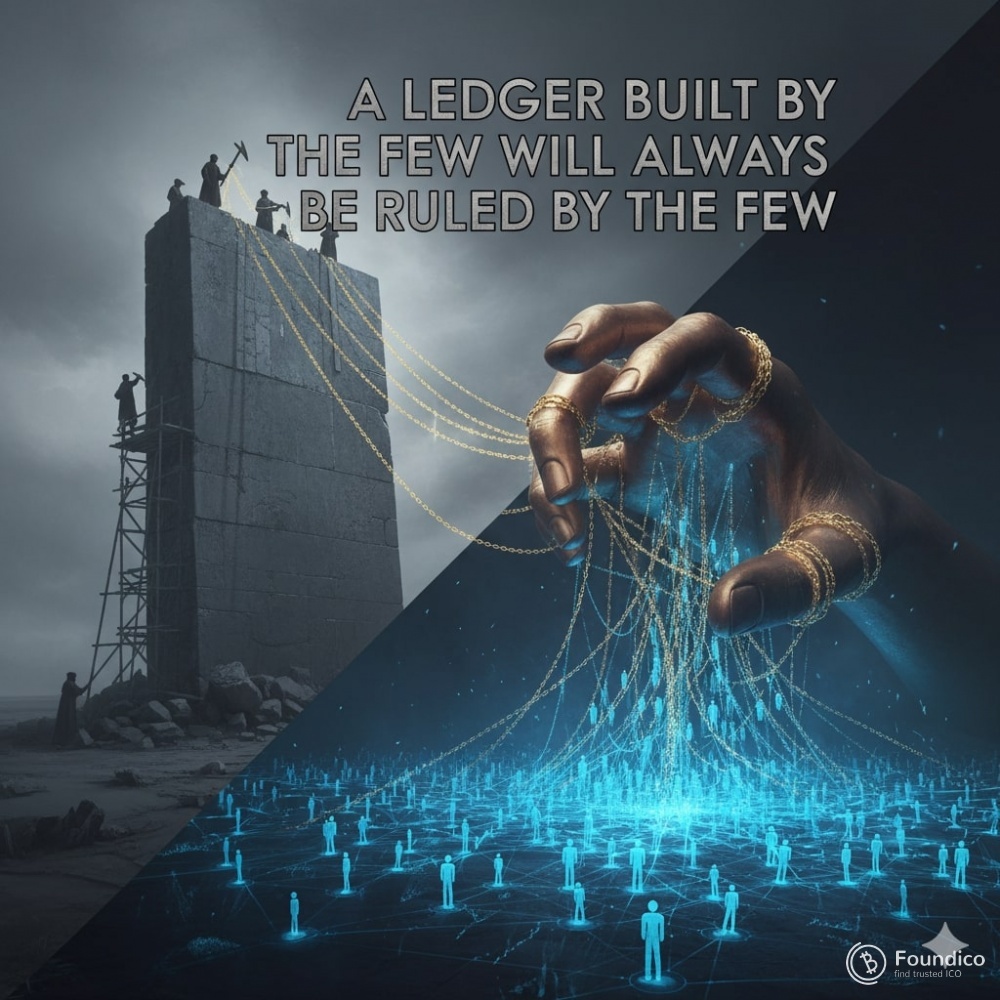A Ledger Built by the Few Will Always Be Ruled by the Few

By Dr. Pooyan Ghamari, Swiss Economist and Visionary
The promise of blockchain technology was revolutionary: a distributed, immutable ledger that would liberate us from centralized control and usher in an era of true digital democracy. Yet, as the industry matures, a troubling reality is becoming increasingly apparent: many of the "decentralized" systems we laud are, in practice, consolidating power into the hands of a select few. This phenomenon leads to an inescapable conclusion, one that underpins the very integrity of the digital economy: a ledger built by the few will always be ruled by the few.
The Centralization Creep
The initial design principles of blockchain aimed for maximal participation. Satoshi Nakamoto envisioned a system where anyone with a computer could contribute to securing the network through mining, ensuring a diverse and distributed set of validators. However, economic incentives, technological complexities, and the pursuit of efficiency have gradually led to a centralization creep across various layers of the blockchain stack:
-
Mining/Validation Pools: For Proof-of-Work chains, the immense computational power required to mine profitably has led to the dominance of large mining pools. Similarly, in Proof-of-Stake systems, the need for significant capital to stake effectively often results in a few large entities or staking services controlling a disproportionate amount of the network's validation power.
-
Infrastructure Providers: Many dApps and even core blockchain infrastructure rely heavily on centralized cloud services (e.g., AWS, Google Cloud) for hosting nodes, front-ends, and APIs. A single outage or policy change by one of these providers can have cascading effects across entire "decentralized" ecosystems.
-
Development and Governance: While protocols are open source, the direction of development and critical upgrades often remains concentrated within a core team or a small group of influential token holders. Their decisions, though theoretically voted on, can steer the entire project, sometimes bypassing the genuine will of a broader community.
-
Exchange and Custody Services: The vast majority of users interact with cryptocurrencies through centralized exchanges and custodial wallets. These entities act as significant gatekeepers, influencing liquidity, listing decisions, and even exercising de facto control over users' assets.
The Inevitable Consequence: Rule by the Few
When the infrastructure, validation, and development of a ledger are concentrated in the hands of a few, the inherent power dynamics shift dramatically.
-
Censorship Risk: If a small number of validators control the majority of the network, they could theoretically collude to censor transactions or exclude participants, undermining the censorship-resistance property of the blockchain.
-
Single Points of Failure: Centralized infrastructure introduces vulnerabilities. A hack, regulatory pressure, or technical failure at a single provider can compromise the entire system, replicating the very risks blockchain was designed to mitigate.
-
Economic Control: Large stakeholders can disproportionately influence governance proposals, pushing through changes that benefit their own interests, potentially at the expense of smaller participants or the network's long-term health. This can lead to a new form of digital oligarchy.
-
Reduced Innovation: A concentrated power structure can stifle innovation by favoring established players or resisting changes that might disrupt the status quo controlled by the few.
Rebuilding for True Decentralization
To truly realize the promise of a decentralized ledger, we must actively work to broaden the base of its builders and rulers. This requires a conscious shift in philosophy and practice:
-
Lowering the Barrier to Entry: Making it easier and more economically viable for individuals to run full nodes, participate in staking, or contribute to development is paramount. This includes user-friendly tools, energy-efficient protocols, and fair economic incentives.
-
Diversifying Infrastructure: Supporting and developing genuinely distributed infrastructure solutions, from peer-to-peer data storage to decentralized DNS, reduces reliance on centralized intermediaries.
-
Empowering Grassroots Governance: Experimenting with novel governance models that prioritize broad participation over concentrated wealth, such as quadratic voting or identity-based mechanisms, can help distribute decision-making power.
-
Education and Advocacy: Continuously educating users about the importance of true decentralization and advocating for open, permissionless systems is crucial to resisting the allure of convenient but centralized solutions.
The allure of efficiency often leads to centralization, but true decentralization is not merely about technological architecture; it is about the distribution of power. If we allow a small cohort to build and maintain the foundational ledgers of our digital future, we must accept that those ledgers will, inevitably, be ruled by them. The time has come to actively dismantle these emerging power structures and recommit to the original vision: a ledger truly built, and therefore truly ruled, by the many.
